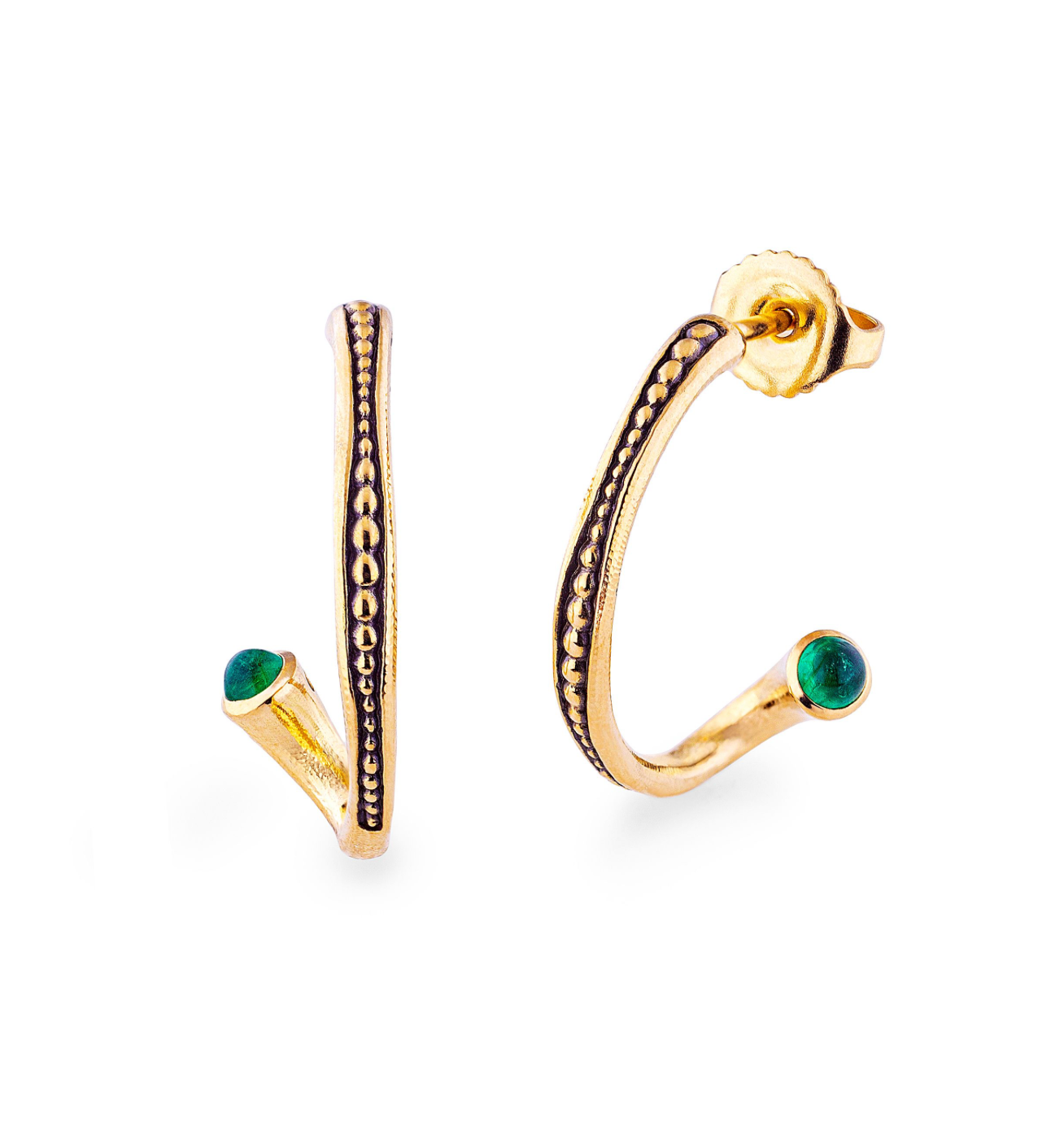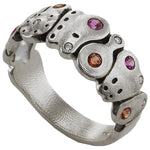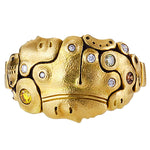Gemstones
- Diamonds
Pure Carbon. The hardest known naturally occuring material and since ancient times the most highly regarded and prized colorless gemstone.
Many of the worlds greatest diamonds have resided in private royal collections or State crown jewels, unfortunately for us non-royals. However several are available for viewing in museums around the world. Those of you visiting London have an opportunity to see the biggest colorless faceted diamond, the Star of Africa, an incomparable 530.20ct pear shaped gem, that resides in the Royal Scepter, which is housed in the Tower of London vault. Also known as the Cullinan I, it was cut from a 3100ct rough diamond. Several other very large diamonds were also cut from this piece, the Cullinan II is a 317ct cushion cut that resides in the Imperial Crown used for State coronations, and again on view in the Tower.
Today, the art & science of cutting has progressed to a previously un-obtainable level.
Hearts On Fire has spear headed this progress, investing hugely in the technology of vibration free cutting, in order to produce the highest levels of perfomance in terms of light interaction. Bottom line, these round diamonds are simply the best looking available. 50% of a polished diamond's value comes from the cutting quality. Don't skimp here!
Other shapes that have endured over the years are known as fancy shapes. Diamond cutters have been quite creative, and depending upon the shape of the rough crystal, have been able to conjure up some amazing polished shapes. Horse heads, crosses to name a few!
We suggest square diamonds cut as either a Dream, by Hearts on Fire for sheer perfection in brilliance, and for a classic elegant enduring look an Asscher cut, which is rather a specific square to very very slightly rectangular emerald cut diamond with a small table (the top facet) and a high crown ( the area above the girdle or edge) and an open culet ( the little facet on the very bottom).
- Colored Diamonds
Natural colored diamonds are some of the earth's rarest and consequently most valuable gemstones. As with most gemstones, the red variety is the most rare and valuable. True red diamonds are exceedingly rare and very expensive per carat, as they should be. Occasionally they are offered for sale. Blue, green, purple, pink and orange are probably the next rarest, and the more common fancy colors are yellow and cognac, with brown being the most commonly occurring.
In terms of valueing a variety of factors have to taken into consideration. The grading reports from GIA now have a comprehensive scale, that shows the hue (color), saturation of color and tone ( amount of grey included). This helps the buyer determine the rarity, now all that they have to do look at te diamond and decide if they like the look of it, as not all colored diamonds have the same effect with each person.
The clarity is also a determining factor, although, generally less so than in white diamonds. Certainly a high clarity colored diamond will command a bigger premium over it's more included sibling, but the color has the biggest influence on value.
Cutting, the style and execution, will also affect the value. Generally the parameters are looser for colored diamonds than white diamonds. Again a finely cut diamond will command a premium over a poorer cut gem of similar color.
Emeralds are the most desirable of green gems. Found in many locations, the most famous come from Colombia. Several other places in the world produce superb emeralds too, Zambia probably being the best known. Very fine stones are sometimes available from Afghanistan and Pakistan, sourced from high up in the Hindu Kush area of the Western Himalaya.
A vibrant slightly bluish green with the least amount of inclusions is the desirable way to enjoy your emeralds. They lend themselves to great center stones mixed with white diamonds, or the classic Three Stone ring, with an emerald flanked by a couple of lovely bright white diamonds.
I work with several gem dealers who source their emeralds from the mines in Colombia and also one particular gem dealer with superb contacts in Pakistan/Afghanistan and Zambia.
I invite inquiries for great emeralds; they make one smile, and are easy on the eye, after all green is possibly the most calming color found in nature.- Garnet
Most garnets are red or reddish brown or purplish red. They have for years been used in jewelry, typically less expensive but quite pretty jewelry. Almandine & rhodolite garnets are found in large quantities in many locations around the world.
An extremely rare and relatively expensive green gem from one small area in the Ural mountains, Russia, the famed Demantoid, has been used in top quality jewels since the late 1800's. With the sweeping changes that occurred after the Russian Revolution, mining and production came to a standstill. As they were found in relatively small sizes and being so rare, most people never see or get to experience them unfortunately! Occasionally fine period jewelry from the Art Nouveau, Edwardian & Art Deco periods will contain a few of these precious jewels. In the recent 10 years or so, Russian exploration & mining has restarted in the Urals, so small amounts of this lovely rare green garnet are finding their way into the market for sale again.
Another of my favorite garnets, is a variety found in East Africa on the Tanzania/Kenya border. Brought to market by the famous Tiffany & Co. as Tsavorite Garnet. It is also a deep rich green color. The name comes from the Tsavo National park in Kenya, where it was discovered. This lovely gem is found in bigger sizes and in more abundance than it's very rare Russian cousin.
Mandarin garnets from East Africa are another lovely variety of garnet, found in a bright orange to orangey-golden color, they are quite bright and lively stones, relatively inexpensive when compared to their green cousins, they are a colored gem lovers delight.
- RubyOften described as the royal gem, it has been prized by kings and queens for ever. The most revered gems historically have come from Burma ( now called Myanmar). Much has been written about the Valley of Gems, in Mogok, found in Northern Burma. The late Dr. Gubelin, possibly the worlds most famous gemmologist, spent many trips to this locale, documenting the geology of the area, acquiring the knowledge to be in a position to determine the source of rubies long before most gemologists of his time were doing this legwork.
Today this area is a bustling city of miners and gem dealers. As the country has been under the fist of an oppressive communist military govt. for many decades, westerners have allways been treated with suspicion and permission to visit the area has been granted rarely. The gems find their way out primarily through govt. sponsored auctions in the capital Rangoon. Certainly smuggling occurs as the risk-reward is taken on by optimistic dealers. Bangkok is the center of the colored stone market, with Thai dealers acquiring most of the finest gems emmanating from Mogok. From here they find their way into the various dealers and jewelers hands, to come onto the market. The finest gems are usually snapped up by dealers, knowing exactly where they are going to sell them. Private collectors are offered these before the general public ever/if at all ever sees them.
Bangkok is the world's center of ruby dealers, with much of the production of Thailand & recently Vietnam's ruby mines also joining the supply line to the world. Good quality ruby in 2-3ct sizes is quite readily available, over 5cts the quality quickly goes downhill, with the exception of a few high quality stones which are fetching quite strong prices due to the rarity.
As a durable gem, ruby is a perfect stone for daily wear in a ring, enhanced by white diamonds, many brides will choose a high quality ruby over a diamond, due to immense rarity and sheer beauty.
- SapphireOf the "Big 4" blue sapphire is the found in more locations and greater quantities than ruby or emerald. The finest examples come from the famous Kashmir area in northern India bordering Pakistan, in fact this area is still disputed by both countries. High up in the Himalayas, the mines are are essentially exhausted at this point, so most of the fine "Kashmir" sapphires are to be found in older jewelry, or if loose, removed from an old piece along the way. Generally they are accompanied by a report from from a reputable gem lab stating origin and usually whether or not any thermal enhancement has taken place. Often described as "Velvety blue", the color is sublime!
Next most desirable would be a fine Blue sapphire from Burma, found in the Mogok area. (See image above) These are more readily available than Kashmirs and often found in bigger sizes. Sri Lanka (formerly Ceylon) produces many fine blue sapphires as well as the "Fancy" colored ones, basically anything other than blue, so gorgeous pinks, purples, oranges and yellows. In the past 10 years or so Madagasgar has come on line as a producer of lovely blue sapphires, occasionally being mistaken for very fine Burmese or Sri Lankan stones.
Other sources for sapphire include Australia, which produces a lot of the lower quality inky/dark blues. Thailand and Cambodia too produce blue sapphire, again generally too dark to be really valuable. Here in the US, Montana has been supplying quite lovely blues primarily, although in really small quantities and typically in small sizes. George Kunz, the famous gemmologist for Tiffany & Co. around a hundred years ago, often used these lovely bright Montana sapphires in some of Tiffany & Co's jewelry. The Arts & Crafts designers from the US also had a fancy for these "homegrown" sapphires, so one will find them used here too.
- SpinelThe most famous Spinel, a red one, is the "Black Prince's Ruby"; found in a prominent location, the front of the state crown of the British Crown jewels in London. For many years it was assumed to be a ruby, until a gemologist finally tested it and discovered it true identity! Red Spinels are found in several locations around the world, with Burma being the most prized source.
One great aspect with Spinels is that they don't receive any treatments to improve the color, a completely naturally occuring beautiful gem, which in the best reds mimics a fine ruby. Prices though do NOT mimic ruby, which I'm happy to report. They are not in-expensive gems, especially when a fine example.
- Tourmaline
Possibly the most famous Tourmaline of recent years is the so called Paraiba. Emanating from a mine in Brazil, these fantastic gems, electric-neon blue, neon green and deep purplish-blue gems were found for a short period of time and became the hottest new find in gemstones of the past 15 years. Selling for many thousands of dollars per carat, collectors snapped them up as the supply drew to an end. Colored by trace amounts of copper, it was the greatest vivid blue gem to occur, with it's almost flourescent colors wowing collectors and consumer alike. Almost as soon as it hit the market, it disappeared, as the mine was quickly exhausted. Today a similarly copper colored blue tourmaline is slightly more readily available from Mozambique, South East Africa, although it doesn't have quite the same electric vivid color. This source has too been exhausted.
Tourmalines are found in many other colors, green being my favourite. Dark blue, called Indicolite, is another lovely variation of Tourmaline. Pinks are also quite highly prized, especially in Asia, where they have been admired for years. Southern CA has been a fantastic source of very fine pink Tourmaline for at least 100 years, they were mined almost as a by product, due to the geology of the area which produced Lithium ore.

Our Location
324 South Cedros Avenue, Solana, CA
Tuesday–Friday 10 AM–5 PM
Saturday 11 AM–5 PM
Sunday–Monday Closed
(858) 794-8000
MAKE AN APPOINTMENT
NEWSLETTER
Be the first to know about new collections and exclusive offers.


